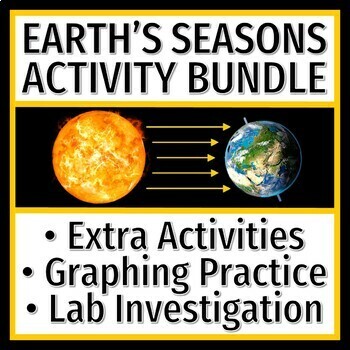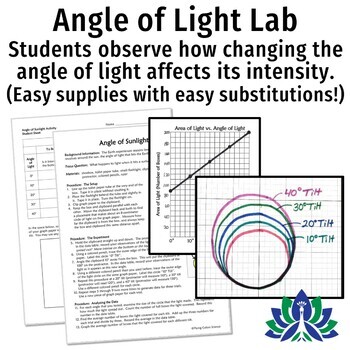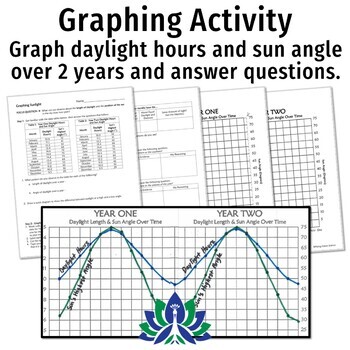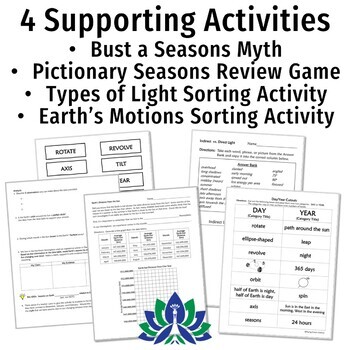Earth's Tilt and Reason for the Seasons Activity BUNDLE NGSS MS-ESS1-1
- Zip

What educators are saying
Products in this Bundle (4)
Bonus
Also included in
- Never search for "something to do tomorrow" ever again! This bundle contains PRINT AND GO lessons, NO PREP activities, LOW PREP labs, and ENGAGING articles to supplement and thoroughly enhance an Earth and space science course. Every included resource is easy to implement, standards-based, and high-Price $399.99Original Price $639.06Save $239.07
Description
SAVE 20% off list prices plus 2 FREE BONUSES! Designed to SUPPLEMENT and add ENGAGEMENT to an existing middle school seasons unit with great activities, an easy supplies lab, and a graphing project. Supports NGSS MS-ESS1-1 and HS-ESS1-4.
BUNDLE INCLUDES:
- Bust a Seasons Myth Activity
- Graph the Sun's Angle & Length of Daylight
- Rotation/Revolution Sorting Activity
- Easy Supplies Angle of Light Lab
- Contrast Indirect/Direct Sunlight Worksheet - FREE BONUS
- Seasons Review Game Activity - FREE BONUS
INDIVIDUAL RESOURCE DESCRIPTIONS:
BUST a Seasons Myth Activity: In this activity, students will:
- GRAPH the distance between the sun and Earth for 12 months of the year (bar graph).
- ANSWER follow-up analysis questions, including a CER.
- CONCLUDE that in the Northern Hemisphere we are NOT closer to the sun in summer!
Rotation/Revolution Sorting Activity: This simple tool helps to review Earth's movements and seasons by giving students 16 terms or diagrams related to the rotation and revolution of the earth. They must decide if each term more closely applies to the "Day" category or the "Year" category. This is a great tool to help them understand the difference between rotation and revolution.
Graph the Sun's Angle & Length of Daylight: Objective: Graph the relationship between the seasons and angle of sunlight, as well as the seasons and length of daylight hours. In this activity, students will:
- GENERATE A GRAPH that shows both the angle of sunlight and the hours of daylight over two years.
- ANSWER follow-up analysis questions, including some in the Claims/Evidence/Reasoning format. Students will be able to make a correlation between the position of the sun in the sky and the season as well as the number of hours of daylight and the season.
Easy Supplies Angle of Light Lab: EASY SUPPLIES! In this activity, students will:
- PERFORM THE LAB: Students aim a flashlight (or a cell phone light) at graph paper at various angles and measure the area that the light spreads. Clear and easy-to-follow instructions are included, as well as a data table to record results.
- GRAPH area of light versus angle of light to see that the larger the angle, the larger the area that the light spreads over and the less concentrated it is.
- ANSWER follow-up analysis questions, including a CER.
Contrast Indirect/Direct Sunlight - FREE BONUS: This is a QUICK but effective little worksheet that reinforces the idea that seasons differ because of the changing angle of sunlight hitting the Earth. The resource gives students a set of 15 phrases such as "spread out", "concentrated", "overhead" etc. and they must write the phrase under either the column "indirect sunlight" or "direct sunlight". There are also 2 simple diagrams to categorize, as well.
Seasons Review Game Activity - FREE BONUS: Simple but engaging concept review! In this Pictionary-style game, pairs or groups of students are challenged to draw pictures of 16 different words or phrases related to seasons and the motions of Earth in space (rotate/revolve). The objective of the game is to draw a picture that represents the phrase on each card so that their team can guess the concept.
Teacher Notes:
- Answer keys included.
- Please note: these PDF resources are not editable.
- Find lots more related resources in the SEASONS SECTION OF OUR STORE.
⭐⭐⭐Click here to get 5 FREE EARTH & SPACE SCIENCE lessons!⭐⭐⭐






